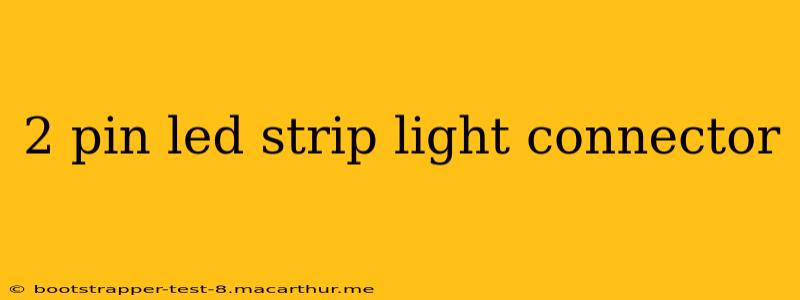Connecting LED strip lights can seem daunting, but understanding the basics of 2-pin connectors makes the process straightforward. This guide will cover everything you need to know about these connectors, helping you confidently tackle your next lighting project. We'll delve into various connector types, troubleshooting common issues, and even address some frequently asked questions.
What are 2-Pin LED Strip Light Connectors?
2-pin LED strip light connectors are small, versatile components used to join sections of LED strip lights together, extending their reach or creating more complex lighting designs. They're typically found on standard 12V and 24V LED strips and simplify installation compared to soldering individual wires. The "2-pin" refers to the two terminals on the connector, usually carrying the positive (+) and negative (-) power lines.
Types of 2-Pin LED Strip Light Connectors
Several types of 2-pin connectors exist, each with its own advantages and disadvantages. The most common include:
-
Standard Wire Connectors: These often come pre-attached to the LED strip. They utilize a simple push-in mechanism or screw-down terminals for connecting wires. These are easy to use but can sometimes be less secure than other options.
-
Quick Connectors: These connectors feature a quick-release mechanism, making it easy to connect and disconnect the LED strips without tools. They're ideal for temporary installations or designs requiring frequent adjustments.
-
Waterproof Connectors: Designed for outdoor or damp environments, these connectors offer added protection against moisture and dust. They typically feature a rubber seal or protective casing.
How to Connect 2-Pin LED Strip Lights
Connecting LED strips with 2-pin connectors is generally a straightforward process. However, always ensure the power is OFF before starting.
-
Identify the Positive and Negative Wires: LED strips usually have clearly marked positive (+) and negative (-) wires, often colored red and black respectively.
-
Prepare the Connectors: If the connectors aren't already attached to the LED strip, carefully solder them onto the ends, paying close attention to polarity.
-
Connect the Strips: Align the connectors and firmly push them together, ensuring a secure connection. For screw-down types, tighten the screws to ensure a good electrical contact.
-
Test the Connection: After connecting the strips, switch the power back on and check that the lights are working correctly.
Troubleshooting Common Issues with 2-Pin Connectors
Several issues might arise when working with 2-pin connectors. Here are some common problems and their solutions:
-
Lights Not Working: Double-check the connections, ensuring polarity is correct and the connectors are securely fastened. Check for any damaged wires or loose connections.
-
Intermittent Lights: This often indicates a loose connection. Firmly reseat the connectors or replace them if necessary. Check for any damage to the wires near the connection point.
-
Connector Failure: If a connector consistently fails, replace it with a new one.
What kind of 2-pin connectors are there for LED strips?
As mentioned earlier, several connector types exist, ranging from simple wire connectors to waterproof designs. The best type depends on your specific application, whether indoor or outdoor, and the frequency of connection/disconnection needed.
Are all 2-pin LED strip connectors compatible?
No, not all 2-pin LED strip connectors are compatible. While they all share the fundamental two-pin design, variations in size, shape, and terminal design can prevent interchangeability. Always check the specifications to ensure compatibility before purchasing connectors.
How can I tell if my LED strip uses 2-pin connectors?
Examine the ends of your LED strip. If you see two wires coming out, then it likely uses a 2-pin connection system, or at least is compatible with 2-pin connectors. The connectors themselves are usually small and unobtrusive.
Conclusion
2-pin LED strip light connectors offer a convenient and efficient way to connect and extend LED strip lighting. Understanding the different types and troubleshooting common issues will significantly improve your DIY lighting project experience. Remember to always prioritize safety and work with the power turned off. With a bit of knowledge and care, you can achieve professional-looking lighting installations effortlessly.
